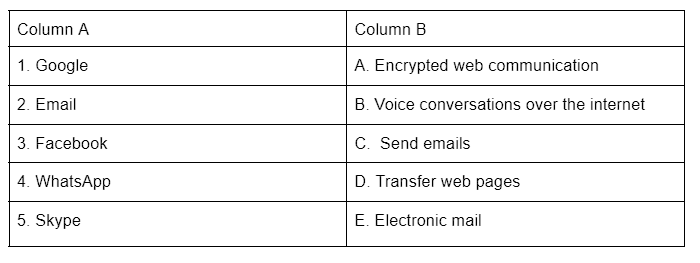Worksheet: Internet & Web Services | Computer Application: Class 10 PDF Download
Q1: Multiple Choice Questions (MCQs)
1. Which of the following is NOT a search engine?
(a) Google
(b) Yahoo! Search
(c) Bing
(d) WhatsApp
2. Which component of an email message includes the sender’s address?
(a) Subject
(b) From
(c) To
(d) Date
3. Which of the following is an example of a social networking site?
(a) Khan Academy
(b) Facebook
(c) W3Schools
(d) Google Drive
4. What does 'Bcc' stand for in an email header?
(a) Blind carbon copy
(b) Blue carbon copy
(c) Black carbon copy
(d) Bright carbon copy
5. Which of the following is a benefit of cloud computing?
(a) High hardware costs
(b) Limited access to applications
(c) Pay-as-you-go services
(d) High software costs
Q2: Fill in the Blanks
1. A blog is a website or part of a website that contains personal diary-type entries in ________ chronological order.
2. E-mail addresses are not ________ sensitive.
3. ________ is a service which allows us to send the message in electronic mode over the internet.
4. Video conferencing makes use of computer networks to send ________ and ________ data from one place to another.
5. ________ involves applications which are used by government agencies to provide better governance.
Q3: Match the Columns

Q4: True/False
1. Video conferencing allows communication only through audio transmission.
2. E-commerce means buying and selling products online.
3. Social networking sites are not used for playing games.
4. The 'To' field in an email header indicates the sender’s address.
5. Cloud computing requires users to purchase expensive hardware and software.
You can access the solutions to this worksheet here.
|
10 videos|97 docs|18 tests
|
FAQs on Worksheet: Internet & Web Services - Computer Application: Class 10
| 1. What are the main differences between the Internet and the World Wide Web? |  |
| 2. How does a web browser work? |  |
| 3. What are some common Internet safety tips? |  |
| 4. What is the role of search engines in accessing information on the Internet? |  |
| 5. What are the basic components of a website? |  |















